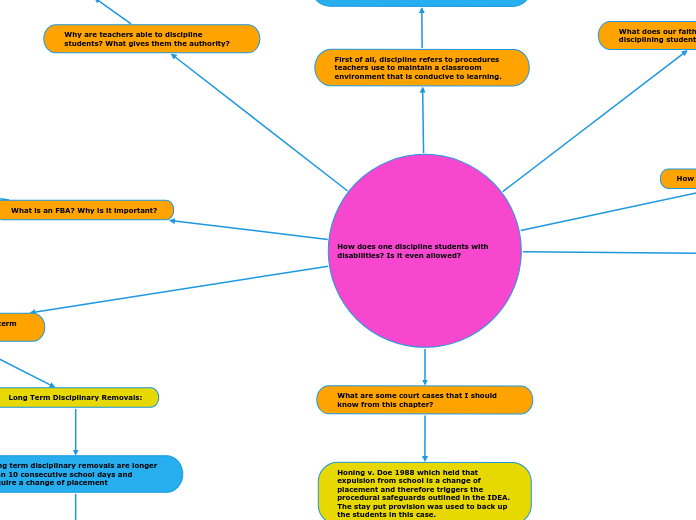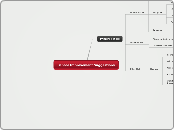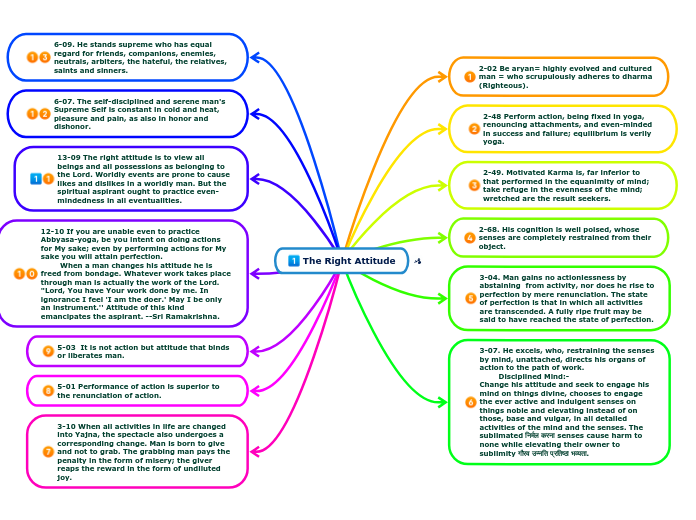How does one discipline students with disabilities? Is it even allowed?
What are some court cases that I should know from this chapter?
Honing v. Doe 1988 which held that expulsion from school is a change of placement and therefore triggers the procedural safeguards outlined in the IDEA. The stay put provision was used to back up the students in this case.
What is the difference between short term and long term disciplinary removals?
Long Term Disciplinary Removals:
Long term disciplinary removals are longer than 10 consecutive school days and require a change of placement
Procedural safeguards of the IDEA are implemented in this case
School officials may exclude a student with disabilities for up to 45 schools days if the student (a) brings weapons to school, (b) knowingly possesses or sells illegal drugs at school, or (c)has inflicted serious bodily injury on another student.
I asked a question to Brother Cloward about a student with special needs being used as a guinea pig for other general education students' antics. brother Cloward says its a case by case situation but most likely the student with special needs as well as the general education student will get in trouble.
Short Term Disciplinary Removals:
Removing a student from the classroom for a short time. This disciplinary action is the exact same for typically functioning students
The removal of a student with disabilities form a classroom when they are having behavioral problems is supported and does not require a convening of the IEP team
Students with disabilities may be removed from the classroom for up to 10 consecutive school days.
If the total number of school days that a student has been suspended reaches 10 days, the school must provide educational services to the student.
Short term disciplinary removal becomes a change in placement when the suspension is for longer than 10 consecutive days and must follow the change of placement procedures as outlined in the IDEA
What is an FBA? Why is it important?
An FBA is a Functional Behavioral Assessment is a test given to students with special needs to address problem behaviors. This process searches for an explanation as to why a student is exhibiting a certain problem behavior.
FBA's are an important part of determining if a student needs a Behavioral Intervention Plan written as well as their IEP. A Behavioral Intervention Plan can only be written after an FBA is conducted.
The FBA is used to develop an understanding of the cause and purpose of a problem behavior. For example a student may be yelling or lashing out because they are frustrated with their communication
What are some procedural and substantive due process procedures for behavioral issues?
Substantive due process:
The right to reasonableness. The regulation of student behavior must be reasonable. Any typical person should be able to look at the discipline and find a rationale, and a school related means to the discipline.
Substantive due process requires that the regulation of student behavior be reasonable. To be reasonable, rules must have rationale and a school related purpose, and the school must employ reasonable means to achieve compliance with the rule.
Proedural due process:
School district must meet the requirements of a reasonable and appropriate school wide discipline policy extending due process protections and must be applied in a nondiscriminatory manner
School districts can meet these requirements by taking actions such as (a) developing reasonable and appropriate school wide discipline policies and procedures, (b) extending due process protections to students when using certain disciplinary procedures, and (c) ensuring that discipline sanctions are applied in a nondiscriminatory manner.
How is discipline at school a balancing act?
Discipline is a balancing act because you are trying yo control the students behavior while also giving them their free agency and ability to choose for themselves.
It has been an issue finding the appropriate spot to place students when disciplining for decades which has brought up quite a few court cases.
If a teacher or principal chooses to use discipline on a student with disabilities that is meant for a typical student, that can be considered discrimination if the student is acting out because of their disability.
Why are teachers able to discipline students? What gives them the authority?
The Courts have adopted the term "in loco parentis" from English Common Law which means parents have acquiesce in the control over their children when their children are placed in the charge of school personnel.
In loco parentis does not mean that the teacher stands fully in place of the parents in controlling their child during the school day, but that the school officials, acting in concert with appropriate laws and regulations, have a duty to maintain an orderly and effective learning environment through reasonable and prudent control of students.
What does our faith have to say about disciplining students with disabilities?
We know that children with disabilities are divine and deeply loved children of God. They have been tasked with a special mission here on earth to spread love and joy.
We as saints believe that Parents should be responsible for the raising up of children including discipline.
But, we also believe that children should grow up obeying the laws of the land and every other rules given to them in the home, school, or community.
Because of this belief we know that our students with disabilities should receive adequate discipline to help them understand what they did wrong and how to reasonably improve in a way that will be beneficial for the student.
First of all, discipline refers to procedures teachers use to maintain a classroom environment that is conducive to learning.
We are not disciplining students in the way that you may think. There is no hitting, yelling, or placing in time out. Discipline is meant to help the student, not hurt them.
"Discipline involves more than just using procedures to control student misbehavior, it is also a means of teaching students about the effects of their behavior on others and to help them learn to control and manage their own behavior."
"Discipline should help maintain an effective classroom environment and positively affect the learning of students in that classroom."









